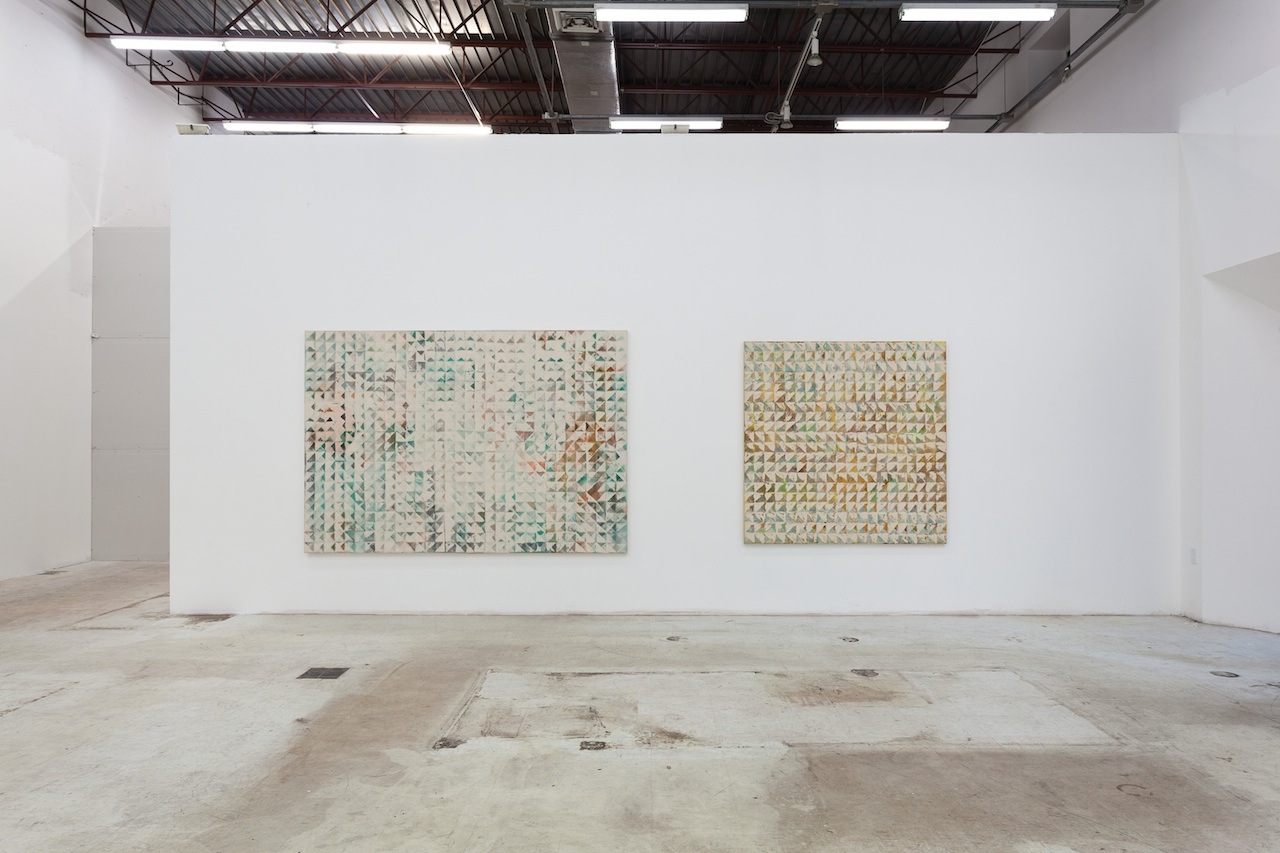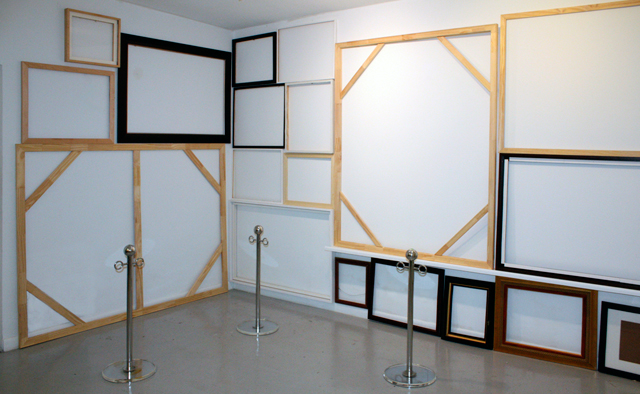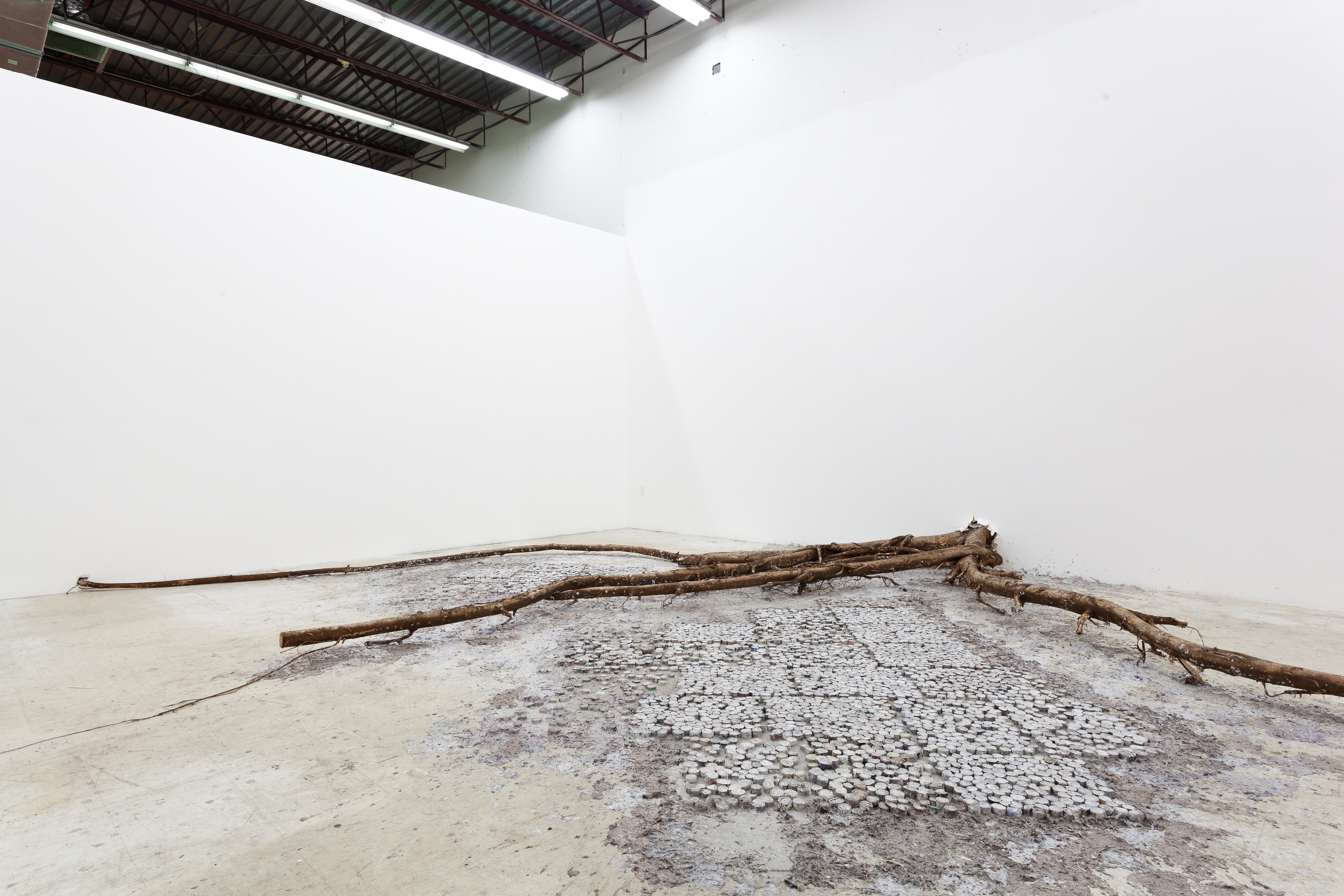
Miami alternative gallery Dimensions Variable looks to the next variation
Lynne Golob Gelfman’s large-scale canvases mesh with the space.
When Dimensions Variable, an artist-run alternative gallery and 2011 Knight Arts Challenge winner, first opened up in September of 2009, it lived up to its promise of being an offbeat, off-kilter space.
Set in a former storefront in the Design District, the gallery was really just the front area of the space, cordoned off from the much bigger section of artists’ studios in the back. It was an odd space to work within, the outer wall being all glass windows and a door, leaving only three walls and the floor for artists to utilize for exhibition purposes. But the inaugural exhibit, “Buildup,” perfectly set the tone for the years to come. Created by New York-based Shane Aslan Selzer and superb Miami sculptor Tom Scicluna, it wasn’t a typical installed show. When it “opened” on Sept. 8, each artist, working individually, came in that evening and, for the next two months, made and placed sculpture to fit in the gallery, until the show’s culmination on Oct. 30. That was when the installation was fully finished–and when it closed.
In retrospect, “Buildup” was such a prescient exhibit. At the time, Dimensions Variable was one of several funky galleries on the stretch of Northeast 38th Street, which also included Spinello Gallery and Locust Projects. But they all knew they were living on borrowed time, with donated spaces from developer Craig Robins. Once the street became an art destination, it came time to tear it down, as the block was sold and is being turned into one of the luxury centers of Miami. Everyone knew that was the deal.
Dimensions Variable’s co-founders, Leyden Rodriguez-Casanova and Frances Trombly, relocated to downtown in 2012. It is a much bigger gallery space–a former warehouse with high ceilings and no windows–but it, too, was courtesy of largess from the development group Miami Worldcenter. And again, it is time for them to move on. The final exhibit in the gallery’s current space will run through October.
Dimensions Variable reflects the vagaries of the art scene in Miami, and really everywhere. Artists are encouraged to move into a down-and-out neighborhood to attract new business with a hip vibe, and when higher-end occupants arrive and the rents go up, the artists move on.
Rodriguez-Casanova and Trombly, who are married and who show their own art locally and internationally, are philosophical about it all. They realize they have been lucky to be on the receiving end in this gentrification process, but they admit they are questioning the next move.
When they were first informed about the redevelopment of their block, they wondered if maybe they would give up the gallery and just concentrate on projects, Rodriguez-Casanova said. But after mulling it over, they decided to continue on with a physical space. Over the past six years, the downtown space has allowed Dimensions Variable to bring in artists from all over the globe, highlight local artists who may have had limited exposure, create work outside of the commercial market and give themselves exposure to other art as well.
“It facilitates our own relationships” and serves as a grass-roots incubator for the development of local culture, he said. “In the end, it was important to us to keep a space.”
Now, the question is whether to look for another discounted location or get one on their own.
“When you pay rent, you get stability,” Rodriguez-Casanova said. On the other hand, paying out is a considerable commitment for an alternative gallery, considering that there is often little guarantee of any money coming back in. Either way, the plan is to reopen in 2016.

Artist Magnus Sigurdarson once covered the old gallery in empty frames, making a sculptural intervention.
Over the years, in both spaces, exhibits have explored painting, minimalist sculpture, sound art and room-size installation–dimensions here are, of course, variable. One great example was a 2011 exhibit, “Absenteeism,” from Miami-based Icelandic artist Magnus Sigurdarson. He covered the walls with empty canvas frames of all sizes, in black, brown and blond-wood colors. Absent were the paintings. In keeping with the gallery’s place and mission, those blank frames seemed to ask what the future would fill them with.
Berlin-based Goran Tomcic turned the downtown space into a glittering wonderland in 2014, hanging floor-to-ceiling wires strung with thousands of golden Mylar cutouts of hearts and flowers and shells–a meticulous installation that was like wondering through a sparkling tapestry.
Long-established painter Lynne Golob Gelfman’s exploration of abstract geometric forms on canvas made up another exhibit, while Cuban transplant Fabian Peña’s “Death of a Printed Story” used only the floor and was framed with sprawling tree roots.

Fabian Peña chose only to use the floor for “Death of a Printed Story.”
In one of the most eclectic exhibits, multimedia artist Candelario came from Havana to build a light-box model in the middle of the gallery. Resembling high-rise public housing in Cuba, it was literally a transmitter tower: those visiting the gallery could call friends or relatives in Havana while standing next to the structure.
That 2014 exhibit, “Personal Luggage,” was curated by Elizabeth Cerejido and represented one of the first direct Cuba-Miami art exchanges. After winning a $60,000 grant in the 2014 Knight Arts Challenge, Cerejido recently led a project called Dialogues in Cuban Art. Seven Cuban-American artists were invited to travel to Cuba (many for the first time) and interact with seven of their counterparts. Rodriguez-Casanova was one.
It was a powerful experience, he said, especially when he saw his childhood home for the first time in decades. But it also reminded him that keeping a gallery open in Miami, where future exchanges with Cuban artists can now be included in the scope of Dimensions Variable, was important.

“Sounds Like,” a group show that was the final summer exhibit at Dimensions Variable.
In “Sounds Like,” the exhibit that just closed, four artists (including Scicluna, who was part of the gallery’s inaugural show) delved into “situations where sound is integral to the structure and composition of the piece,” according to the exhibition notes. “The sound element of this work resists quick categorization and allows things to remain mysterious a few moments longer. There is value in not knowing, and it’s ok to not be certain just what that value is.”
With its uncertain future, Dimensions Variable is itself exploring the value of not knowing right now, although they do have some plans. On August 7 and 14 at 8 p.m., the gallery will present “Voleur (thief),” a two-hour performance from Jamilah Sabur and Andy Robert. In September, Locust Projects founder (and former Design District neighbor) Elizabeth Withstandley returns to Miami with a two-channel video installation featuring the 82 current and former members of quirky symphonic rock band The Polyphonic Spree.
And Trombly and Rodriguez-Casanova have already invited several artists for 2016, even though no one knows what the new space will look (or sound) like. It’s okay not to be certain–everyone will just have to fill in the new frame.
Recent Content
-
Artsarticle ·
-
Artsarticle ·
-
Artsarticle ·
